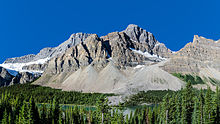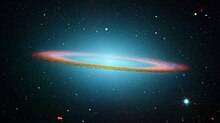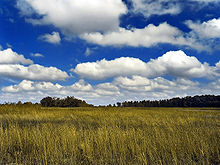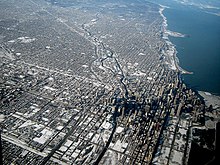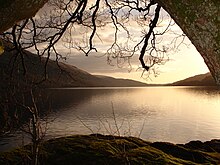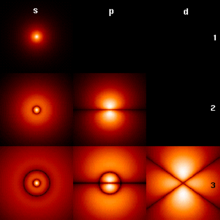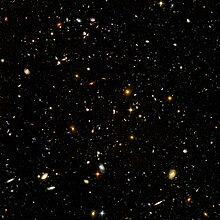Nature
Nature is a concept used to refer to the material world or material universe, including the phenomena of the physical world, inert matter generated as part of processes without human intervention, and to the phenomenon of life, which also includes humans. Nature extends from the subatomic to the galactic world. The word "nature" comes from the Latin natura which means "belonging or relative to nature or according to the quality or property of things", "natural character". Nature is also differentiated from the supernatural.
The concept of nature as a whole—the physical universe—is a more recent concept that has come into increasing use with the development of the modern scientific method in recent centuries.
Within the many current uses of this word, "nature" can refer to the general domain of various types of living things, such as plants and animals, and in some cases to the processes associated with inanimate objects, such as rocks, as well as the weather, the geology of the Earth and the matter and energy that all these entities possess. The term nature does not include artificial objects, created as part of human intervention.
The term «nature» is often contrasted with other terms related to human activity, such as «society», «culture» or «human intervention». For example, "natural environment" is considered to be all those components of a certain landscape that have not been substantially altered by humans or that persist despite human intervention. This more traditional concept of natural things implies a distinction between the natural and the artificial, understanding the artificial as something executed by a human mind or consciousness. However, many environments perceived as "natural" are actually heavily managed and controlled environments. intervened by human action, for example, natural parks.
In a colloquial way, terms such as "human nature" are used to refer to supposed intrinsic conditions of humans that would explain certain attitudes or social behaviors.
The Earth
The Earth is the fifth largest planet in the solar system and the third in order of distance from the Sun. It is the largest of the telluric or inner planets and the only place in the universe where it is known that there is life
The most prominent features of Earth's climate are its two large polar regions, two relatively narrow temperate zones, and a broad equatorial, tropical, and subtropical region. Precipitation patterns vary greatly from place to place, from several meters of water per year to less than one millimeter. About 70 percent of the Earth's surface is covered by saltwater oceans. The remainder consists of continents and islands, with most of the habitable Earth situated in the northern hemisphere.
Earth has evolved through geological and biological processes that have left traces of original conditions. The outer surface is fragmented into several tectonic plates that move very slowly as geological time progresses (although at least several times in history they have changed position relatively quickly). The planet's interior remains active, with a thick layer of molten materials and an iron-rich core that generates a powerful magnetic field. The atmospheric conditions have varied significantly from the original conditions due to the presence of life forms, which create an ecological balance that stabilizes the surface conditions. Despite large regional variations in climate due to latitude and other geographic factors, the long-term mean global climate is fairly precisely regulated, and variations of a degree or two in mean global temperature have had very large effects on the climate. ecological balance and in the geography of the Earth.
Based on the available evidence, scientists have gathered detailed information about the planet's past. Earth is believed to have formed approximately 4.55 billion years ago from the protosolar nebula, along with the Sun and other planets. The Moon formed relatively soon after (approximately 20 million years later, 4.53 billion years ago).). Initially molten, the outer shell of the planet cooled, giving rise to the solid crust. Gas emissions and volcanic activity formed the primordial atmosphere. Condensation of water vapor, along with ice from comets impacting Earth at the time, created the oceans. High-energy chemistry is believed to have produced a self-replicating molecule approximately 4 billion years ago.
Continents formed, drifted apart, and joined again over hundreds of millions of years, sometimes combining to form a supercontinent. About 750 million years ago, the first known supercontinent, Rodinia, began to fracture. Later, the continents joined again to form Pannotia, which split approximately 540 million years ago. The last supercontinent we know of is Pangea, which began to break up approximately 180 million years ago.
There is significant evidence, still disputed among the scientific community, that a severe ice age during the Neoproterozoic covered much of the planet in a thick layer of ice. This hypothesis has been called the "Snowball Earth", and is of special interest, since it precedes the Cambrian explosion in which multicellular life forms began to proliferate, 530-540 million years ago.
Since the Cambrian explosion there have been five major mass extinctions. The last mass extinction occurred about 65 million years ago, when a meteorite strike probably caused the extinction of the dinosaurs and other large reptiles, but did not that of small animals such as mammals, which at that time resembled shrews. Over the next 65 million years, mammals diversified.
Several million years ago, a species of small African ape acquired the ability to stand upright. The subsequent advent of human life and the development of agriculture and, later, civilization, allowed humans to impact on Earth more than any previous life form, in a relatively short period of time. Human actions influence both the nature and quantity of other forms of life, as well as the global climate.
A survey conducted by the American Museum of Natural History in 1998 revealed that 70% of biologists viewed the current era as part of a mass extinction event, the Holocene mass extinction, which would be the fastest of all known Some experts, such as E. O. Wilson of Harvard University, predict that human destruction of the biosphere could cause half of all species to go extinct in the next 100 years. this current extinction is still being investigated, discussed and calculated by biologists.
Weather and Climate
The Earth's atmosphere is a key factor that sustains the planetary ecosystem. This thin layer of gases that surrounds the Earth is held in place by the planet's gravity. It is composed of 78% nitrogen, 21% oxygen and traces of other gases. Atmospheric pressure decreases with altitude. The Earth's ozone layer plays an essential role in reducing the amount of ultraviolet radiation that reaches the surface. Since DNA can be easily damaged by this radiation, the ozone layer acts as a shield that protects life on the surface. The atmosphere also retains heat at night, thereby reducing daily temperature extremes.
Variations in weather occur almost exclusively in the lower part of the atmosphere, and it acts as a convective system to redistribute heat. Ocean currents are another important factor in determining climate, especially the submarine thermohaline circulation, which distributes heat energy from the equatorial oceans to the polar regions. These currents help moderate the temperature differences between winter and summer in temperate zones. Furthermore, without the redistributions of heat energy by ocean and atmospheric currents, the tropics would be much warmer and the polar regions much colder.
Weather can have both beneficial and detrimental effects. Extreme weather events, such as tornadoes or hurricanes, can expend large amounts of energy in their path, wiping out everything in their path. Surface vegetation has developed a dependency on seasonal weather variation, and sudden changes, even if they last only a few years, can have a devastating effect, both on the vegetation and on the animals that depend on it for food.
Planetary climate is a measure of the trend of weather over time. It can be influenced by several factors, such as ocean currents, surface albedo, greenhouse gases, variations in solar luminosity, and changes in the planet's orbit. Based on historical records, we now know that the Earth has experienced drastic climate changes in the past, including ice ages. The climate of a region depends on a number of factors, such as latitude. A latitudinal strip of the surface with similar climatic characteristics forms a climatic region. On Earth, there are several such regions, ranging from a tropical climate at the equator to a polar climate at the poles. Time is also influenced by the seasons, which result from the tilt of the Earth's axis with respect to its orbital plane. In this way, at any given time during summer or winter, there is a part of the planet that is most directly exposed to the Sun's rays. This exposure alternates as the Earth describes its orbit. At all times, regardless of the season, the northern and southern hemispheres experience opposite weather conditions.
Weather is a chaotic system that can be easily changed by only minor changes in the environment, so accurate weather forecasts are only limited to a few days. Taken together, two things are happening globally: (1) the temperature is increasing on average; and (2) weather patterns are changing and becoming increasingly chaotic.
Life
The fact that the most basic forms of plant life began to carry out photosynthesis was key to the creation of conditions that allowed the development of more complex forms of life. The oxygen resulting from the process accumulated in the atmosphere and gave rise to the ozone layer. The symbiotic relationship between small cells and larger cells gave rise to the development of even more complex cells called eukaryotes. The cells grouped into colonies and began to specialize, giving rise to true multicellular organisms. Thanks to the ozone layer, which absorbs harmful ultraviolet radiation, life colonized the Earth's surface.
Although there is no universal consensus on the definition of life, scientists generally accept that the biological manifestation of life is characterized by the following factors or functions: organization, metabolism, growth, adaptation, response to stimuli and reproduction. In a simpler way, we can consider life as the characteristic state of organisms. The properties common to terrestrial organisms (plants, animals, fungi, protists, archaea and bacteria) are the following: they are cellular, they have a complex organization based on water and carbon, they have a metabolism and the ability to grow, respond to stimuli and reproduce. Therefore, an entity that meets these properties is considered to be alive. However, not all definitions of life consider all of these properties essential.
The biosphere is the part of Earth's outermost layer—comprising air, land, surface rocks, and water—within which life occurs, and where, in turn, life occurs. biotic processes are altered or transformed. From the geophysical point of view, the biosphere is the global ecological system that integrates all living beings and their relationships, including their interaction with the elements of the lithosphere (rocks), the hydrosphere (water), and the atmosphere (air).. Currently, it is estimated that the Earth contains about 75 billion tons of biomass (the mass of life), which lives in various environments within the biosphere. About nine-tenths of the total biomass on Earth is life plants, on which animal life is closely dependent. To date, more than 2 million species of plants and animals have been identified, and estimates of the actual number of extant species vary from a few million to nearly 50 million The number of individual species fluctuates constantly: new species appear and others cease to exist, on an ongoing basis. Today, the total number of species is experiencing a rapid decline.
The difference between animal and plant life is not as clear-cut as it may seem, since there are some living beings that combine characteristics of both. Giuliana divided all living things into plants, which generally do not move, and animals. In Charles Linnaeus's system, these became the kingdoms Vegetabilia (later Plantae) and Animalia. Since then the kingdom Plantae, as originally defined, was seen to include several unrelated groups, so fungi and various groups of algae were removed and moved to new kingdoms, although they are often still considered plants in general. some contexts. In flora, bacterial life is sometimes included, so much so that certain classifications use the terms bacterial flora and vegetal flora separately.
One of the many ways to classify plants is by regional floras, which, depending on the purpose of study, may also include fossil flora, which are remnants of plant life from bygone eras. Many people from various regions and countries take pride in their characteristic flora, which varies widely across the globe due to differences in climates and soils. The regional flora is usually divided into subcategories such as native flora and agricultural and garden flora (the latter being those intentionally cultivated by man). Some kinds of "native flora" have actually been introduced centuries ago by migrants from one region or continent to another, and over time have become part of the native or natural flora of the place where they were introduced. This is an example of how human action can blur the lines of what counts as nature. Another category of plants is that of “weeds”. Although the term has fallen out of use among botanists as a way of designating “useless” plants, its informal use (to describe cluttering plants that must be removed) perfectly illustrates the general tendency of individuals and societies to pretend alter the course of nature. Similarly, animals are often classified as domestic, farm, wild, pests, etc. according to the relationship they have with human life.
Animals as a category have several characteristics that set them apart from other living things. Animals are eukaryotic and usually multicellular (see Myxozoa, however), which distinguishes them from bacteria, archaea, and most protists. They are heterotrophs, and generally digest food in an internal organ, which makes them different from plants and algae. They are also distinguished from plants, algae, and fungi in that they lack cell walls. With a few exceptions, notably sponges (Phylum porifera), animals have an organism made up of various tissues, including muscles, capable of contracting and controlling locomotion, and a nervous system, which sends and processes signals. In most cases, they have an internal digestive system. The eukaryotic cells that all animals have are surrounded by a characteristic extracellular matrix, composed of collagen and elastic glycoproteins. It can calcify to form structures such as shells, bones, and spicules, in which the cell moves and reorganizes during its development and maturation, and which support the complex anatomy necessary for locomotion.
Although humans currently make up only half of one percent of the total living biomass on Earth, which estimates the global weight to be about 60 kg on average), total human biomass is the average weight multiplied by the current human population of approximately 6.5 billion people. (see)
Ecosystems
An ecosystem is a relatively autonomous dynamic system, made up of a natural community and its physical environment. The concept, which began to be developed between 1920 and 1930, takes into account the complex interactions between organisms (plants, animals, bacteria, algae, protozoa and fungi, among others) that make up the community and the flows of energy and materials that make it up. traverse.
All forms of life have a need to relate to the environment in which they live, and also to other forms of life. In the XX century, this premise gave rise to the concept of ecosystems, which can be defined as any situation in which there is an interaction between organisms and their environment. Ecosystems consist of biotic and abiotic factors that work in an interrelated manner. The most important factors in an ecosystem are: soil, atmosphere, solar radiation, water, and living organisms. Every living organism has a continuous relationship with all the other elements in its environment. Within the ecosystem, the species are related and depend on each other in the so-called food chain, and exchange matter and energy both among themselves and with their environment. Michael Pidwirny, in his book Fundamentals of Physical Geography, describes the concept thus:
Ecosystems are dynamic entities composed of a biological community and an abiotic environment. The abiotic and biotic composition of an ecosystem and its structure is determined by the state of a number of factors related to each other. Any change in any of these factors (e.g. nutrient availability, temperature, light intensity, population density of a species...) will result in dynamic changes in the nature of these systems. For example, a fire in a tempered caddy forest completely changes the structure of that system. There are no longer large trees, most of the moss, herbs and bushes that populated the forest floor have disappeared and the nutrients stored in the biomass are quickly released to the soil, to the atmosphere and to the hydrological system. After a short recovery period, the community that used to be large mature trees, has now become a community of herbs, herbaceous species and seedlings.
All species have tolerance limits to factors that affect their survival, their reproductive success, and their ability to continue to grow and interact sustainably with the rest of their environment. These in turn can influence these factors, the consequences of which can spread to many other species or even to the whole of life. The concept of ecosystem is, therefore, an important object of study, since such study provides us with the information needed to make decisions about how human life can interact in ways that allow the various ecosystems to grow sustainably into the future, rather than plunder them. For such a study a smaller unit called microecosystem is taken. For example, an ecosystem can be a stone with all the life it houses. A macroecosystem could comprise an entire ecoregion, with its watershed.
The following ecosystems are examples of those currently under intensive study:
- “ continental ecosystems”, such as “forest ecosystems”, “ prairie ecosystems” such as steppes or savannahs), or agro-ecosystems,
- systems in indoor waters, which in turn are subdivided into lénticos (lagos or ponds) and lactic (goats)
- Ocean ecosystems.
Another classification of ecosystems can be made according to their communities, as in the case of a human ecosystem. The broadest classification (today subjected to extensive study and analysis, and also the subject of discussions about its nature and validity) is that of the entire set of life on the planet seen as a single organism, known as the Gaia hypothesis.
Relation of the human being with nature
The development of technology by the human race has allowed a greater exploitation of natural resources and has helped to alleviate part of the risks of natural hazards. However, despite this progress, the fate of human civilization is closely tied to changes in the environment. There is a very complex feedback system between the use of advanced technology and changes in the environment, which is only now beginning to be understood, albeit very slowly.
Humans use nature for both economic and leisure activities. Obtaining natural resources for industrial use continues to be an essential part of the global economic system. Some activities, such as hunting and fishing, have both economic and leisure purposes. The appearance of agriculture took place around the 9th millennium BC. From food production to energy, there is no doubt that nature is the main driver of economic wealth.
Humans have used plants for medicinal purposes for thousands of years. Plant extracts can treat cramps, rheumatism, and lung inflammation. While science has allowed us to process and transform these natural substances into pills, dyes, powders, and oils, the market economy and position of "authority" that credits to the medical community have made its use less popular. The term "alternative medicine" is frequently used to designate the use of plants and natural extracts for curative purposes.
Man-made threats to nature include pollution, deforestation, and disasters such as oil slicks. Humanity has intervened in the extinction of some plants and animals.
Wilderness areas
A wilderness or wilderness area is a natural environment on Earth whose processes or dynamics are autonomous. Ecologists consider wilderness areas to be a part of the planet's natural ecosystem (the biosphere).
The expression “wilderness” immediately evokes the idea of “wilderness”, that is, that humans cannot control. From this point of view, it is the autonomous development of the processes of a natural area that turns it into a wilderness.
Not to be confused with "wild" with "virgin". An area will be virgin if it has not been altered by human presence or activity. Today, practically the entire surface of the planet has suffered, to a greater or lesser degree and directly or indirectly, some type of alteration caused by human beings (even if it is only the influence of climate change or certain pollutants), then it can be affirmed that there are practically no virgin environments in the biosphere. However, the mere presence or human activity does not necessarily imply that an area is no longer wild. Many ecosystems that are, or have been, inhabited or influenced by human activities can be considered “wild”, despite not being virgin. According to this, the areas in which natural processes take place without noticeable human interference are wild.
The notion of “wilderness” has been an important theme in the visual arts during various eras of world history. During the Tang Dynasty (618-907) there was an early tradition of landscape painting. This tradition of depicting nature as is became one of the goals of Chinese painting and had a significant influence on Asian art.
In the Western world, the idea of “wilderness” (wilderness, etc.) as an intrinsic value appeared in the 1800s, especially in the works of the Romantic movement. British artists such as John Constable and Joseph Mallord William Turner dedicated themselves to capturing the beauty of the natural world in their paintings. Before, the paintings had been mostly religious scenes or human beings. William Wordsworth's poetry describes the wonders of the natural world, once seen as a threatening place. Increasingly, the appreciation of nature became an aspect of Western culture.
Representations of nature in art
The beauty of nature is a recurring theme in modern life and in art: books extolling it fill large shelves in libraries and bookstores.[citation needed] That face of nature, which art (photography, painting, poetry...) has portrayed and praised so much, reveals the strength with which many people associate nature with beauty. The reason for the existence of this association and what it consists of constitute the field of study of the branch of philosophy called aesthetics. Beyond certain basic characteristics of nature in whose beauty most philosophers agree, the opinions are practically infinite.
Many scientists, who study nature in a more specific and organized way, also share the idea that nature is beautiful. French mathematician Jules Henri Poincaré (1854-1912) said:
The scientist does not study nature because it is useful, but because it captivates him, and captivates him because he is beautiful.
If nature were not beautiful, it would not be worth knowing it, and if it were not worth knowing it, it would not be worth living. Of course, I do not refer here to the beauty that stimulates the senses, that of the qualities and appearances; it is not that I delude it, at all, but that this nothing has to do with science. I am referring to the deepest beauty, which comes from the harmonious order of the parties and which can capture a pure intelligence.
A classic idea of the beauty of art involves the word mimesis, that is, the imitation of nature. In the domain of ideas about the beauty of nature, the perfect evokes symmetry, exact division, and other perfect mathematical formulas and notions.
In classical Greece, one of the main themes of Plato's Phaedrus is nature.
Matter and energy
Some fields of science in nature as "matter in motion", obeying certain "natural laws" that science is responsible for discovering and understanding.
Matter is usually defined as the substance of which physical objects are composed, and constitutes the observable universe. According to the theory of special relativity, there is no unalterable distinction between matter and energy, since matter can be converted into energy (see particle-antiparticle annihilation), and vice versa (see matter creation). The visible components of the universe are now thought to constitute only 4 percent of the total mass, with the remainder consisting of 73 percent dark matter and 23 percent cold dark matter. The exact nature is still unknown. of these components, which are being thoroughly investigated by physicists.
The behavior of matter and energy in the observable universe seems to correspond to well-defined physical laws. These have been used to create cosmological models that satisfactorily explain the structure and evolution of the universe that we can observe. The mathematical expressions of physical laws employ a set of twenty physical constants that, throughout the observable universe, appear to be static. Their values have been measured with great precision, but why they have those specific values and not others remains a mystery.
Nature beyond Earth
Outer space, also called plain space, designates the relatively empty regions of the universe outside the atmospheres of celestial bodies. The adjective exterior is added to distinguish it from airspace. There is no definite boundary between the Earth's atmosphere and space, since the latter gradually attenuates as altitude increases. The cosmic space located within the limits of the Solar System is known as interplanetary space, whose limit with interstellar space is what we know as the heliopause.
Although outer space is vast enough, it is not empty. There are several dozen organic molecules discovered to date thanks to rotational spectroscopy, microwave background radiation and cosmic radiation, formed by ionized atomic nuclei and various subatomic particles, although scattered in a very scattered manner. There is also some gas, plasma, cosmic dust, and small meteors. In addition, human beings have left traces of their activity in outer space, through materials from manned and unmanned launches. All these objects have been called "space junk" and constitute a potential hazard for spacecraft. Some fall into the atmosphere periodically.
Planet Earth is currently the only known celestial body within the solar system in which life exists. However, recent findings suggest that, in the distant past, the planet Mars had masses of liquid water on its surface. For a brief period in the history of Mars, it may have been capable of supporting life. However, today most of the water on Mars is frozen. If there were still life on Mars, it would most likely be located underground, where liquid water could still exist.
Conditions on the other telluric planets, Mercury and Venus, appear to be too hostile for life as we know it to develop there. But it has been conjectured that Europa, Jupiter's fourth largest moon, may have an underground ocean of liquid water, and it would be possible that life existed in it.
Contenido relacionado
Rhetoric
Duḥkha
Cell theory
